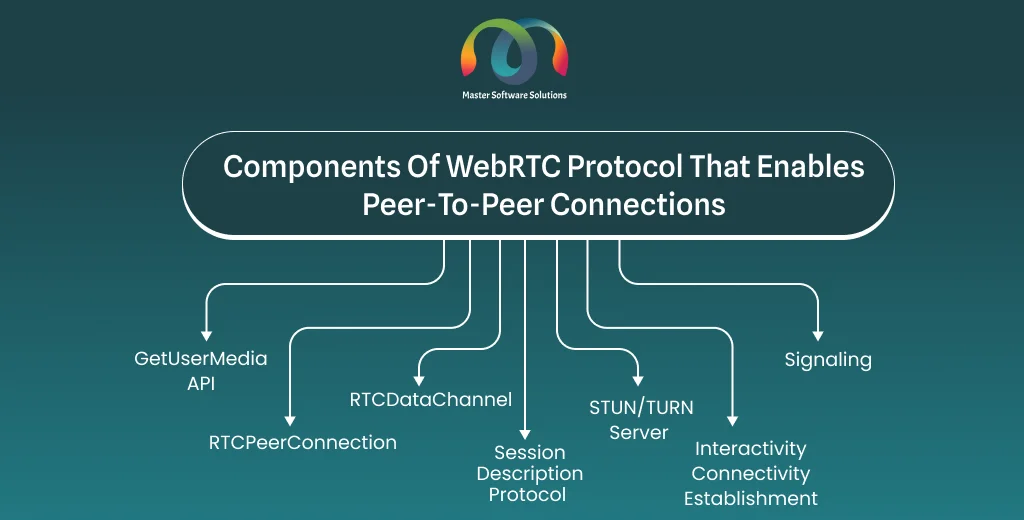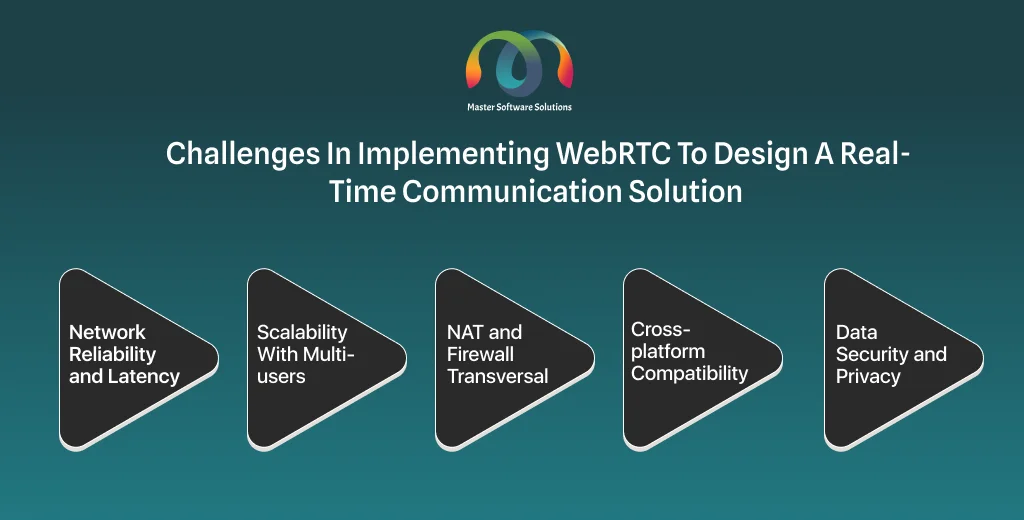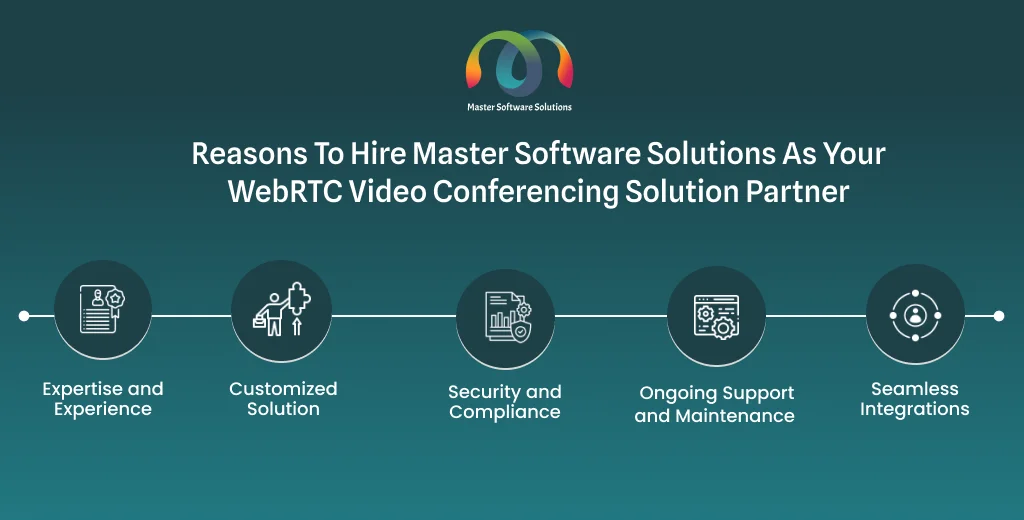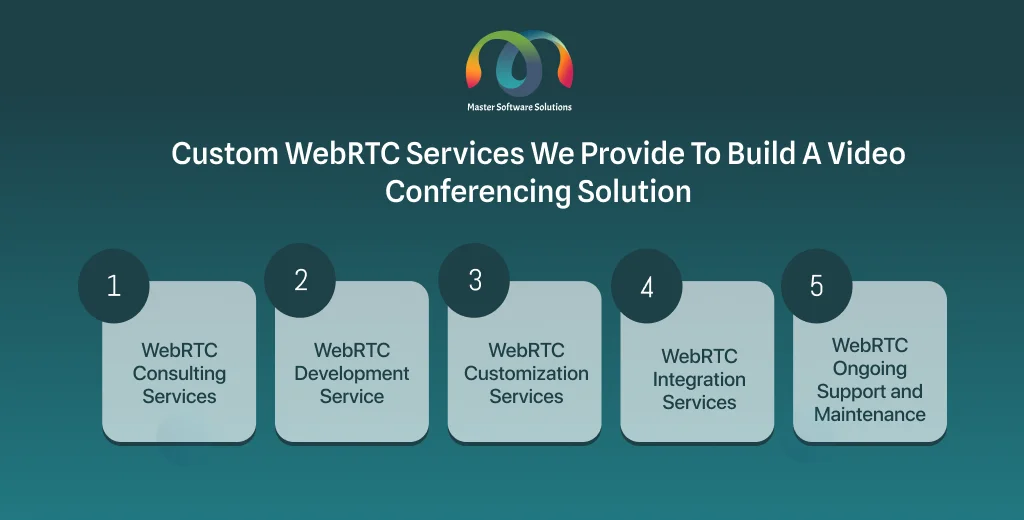Having seamless communication is the building block of a successful business. You need a reliable and efficient video conferencing platform, if you want to connect to your team remotely, hold virtual meetings, or offer online consultation. At Master Software Solutions, we design high-quality, custom WebRTC videoconferencing solutions with functionalities that fit your business type. We are a renowned WebRTC video conferencing solution provider who can help you develop a powerful, secure, scalable real-time communication platform.
Learn how we can help you transform how you connect, collaborate and grow.
This blog covers;
Understanding WebRTC (Web Real-time Communication)
WebRTC or Web Real-time Communication, is an open-source protocol that allows you to build real-time communication solutions on its framework without third-party plugins or software. The platform enables you to establish peer-to-peer (P2P) connections for audio/video and arbitrary file sharing. WebRTC is used for video chats and conferencing on video calling platforms, like Google Meet, Slack, Zoom, or Microsoft Teams.
The WebRTC protocol enables peer-to-peer connections to be established in real-time. These components are:
GetUserMedia API
It captures the media (audio, video, or both) from devices like cameras and microphones to initiate the media stream. These media streams are transmitted via WebRTC.
RTCPeerConnection
It handles media streams and establishes and maintains real-time connections between peers. The process involves establishing a connection between the peers, encoding and decoding media, adjusting bandwidth and latency, and establishing NAT transversal using ICE (Interactivity Connectivity Establishment).
RTCDataChannel
The real-time communication data channel allows users to share data files, like arbitrary file data, messages, etc., alongside media streams in a peer-to-peer connection. It enables you to exchange data, not limited to just media (e.g., multiplayer gaming, and collaborative tools).
Session Description Protocol (SDP)
Defines the multimedia sessions and negotiates parameters, like codec, format, and transmission methods between peers. It exchanges the description of the media format and connection details to establish the connections between peers.
STUN/TURN server
STUN or Session Transversal Utilities for NAT, discovers a public IP address to allow devices to connect behind NATs. TURN or Transversal Using relays around NAT relates to the traffic when establishing a peer-to-peer connection is impossible. These servers assist when direct paths for connections are unavailable to establish direct connections between the users.
ICE (Interactivity Connectivity Establishment)
It helps determine and identify the best possible network routes to connect peers. ICE establishes peer-to-peer connections, overcoming network issues, like firewalls and NAT.
Signaling
It exchanges metadata, like SDP and ICE, to handle the initial handshake between peers. Signaling is typically initiated using WebSockets, HTTP, or protocols.
Features of WebRTC – Real-time Communication
WebRTC offers various functionalities that enable you to establish real-time P2P connections without third-party plugins or software. They allow you to build real-time communication solutions from simple video chats to complex, large-scale conferencing systems.
The major functionalities of WebRTC are:
Real-time audio/video connections
It enables you to transmit audio/video streams between the users seamlessly in real-time. It is primarily used in video conferencing apps, telehealth platforms, virtual classrooms, and online meetings.
Data Channel Communication
You can exchange data, like text, files, or gaming data, in a P2P connection. This feature is apt for multiplayer gaming, live collaborations, and file sharing.
Media stream handling
The platform captures, processes, and manages audio and video streams from cameras and microphones. They are used in advanced WebRTC platforms, like live streaming, virtual consultation, and remote assistance.
Connection management
It can handle tasks, like connection setup, codec negotiation, data flow control, and managing P2P connections. It establishes and maintains stable connections for one-on-one and group calls.
NAT and firewall transversal
The platform uses protocols, like ICE, STUN, and TURN, to establish P2P connections behind firewalls and NATs. These protocols ensure reliable communications in a strictly network-restriction environment in corporate settings.
Adaptive bitrate and network optimization
The WebRTC platform dynamically adjusts audio and video quality based on the network conditions to ensure smooth communication. Adaptive bitrate is critical to maintaining stable calls in an environment with fluctuations in bandwidth.
Encryption and security
The system uses SRTP and DTLS to provide end-to-end encryption to secure media streams and data channels. It ensures privacy and security for sensitive communications, such as telemedicine and financial consultations.
Multi-party communication support
The platform incorporates SFUs (Selective Forwarding Units) and MCUs (Multipoint Control Units) to support multi-user video conferencing. This functionality, enables you to hold group meetings, webinars, and large-scale virtual events with multiple participants.
Interoperability
WebRTC provides cross-platform support across all the major browsers and mobile devices without additional plugins. It simplifies the web-based application deployment process and ensures a broad user reach.
Customizable signaling
You can implement custom signaling protocols to establish and manage connections. It allows you to integrate existing infrastructure or build custom communication workflows.
Challenges in implementing WebRTC to design a real-time communication solution
WebRTC is an open-source platform that allows you to customize the platform and integrate third-party APIs to enhance its functionalities and align with a particular user case. Customizations and integration on WebRTC are complex. You need a WebRTC videoconferencing solution provider to ensure a reliable and scalable real-time communication solution. Some of the challenges you might face are:
Network reliability and latency
It is crucial to ensure consistent performance regardless of the network conditions, especially when you have fluctuating bandwidth, high latency, and packet loss. These issues can lead to delays, video freezing, or dropped calls. You need expertise in implementing adaptive bitrate streaming and using a TURN server for better network transversal.
Scalability with multi-user
Handling large group calls and conferences efficiently needs WebRTC scaling. Inefficient scaling can lead to CPU usage, bandwidth consumption (the amount of data transferred between users in a period), and network traffic. You need extensive knowledge of SFUs (Selective Forwarding Units) or MCUs (Multipoint Control Units) to handle high traffic.
NAT and firewall transversal
You should successfully establish a peer-to-peer connection even when the users are behind NATs or firewalls. If your real-time solution does not bypass these firewalls, it might lead to failed or unstable connections. To establish connections, you must have the expertise and know how to implement ICE with STUN and TURN servers. This facilitates connections in restrictive network environments.
Cross-platform compatibility
You must ensure that your real-time communication platform gives consistent performance and features and can be operated on various browsers and devices. These browsers and divides should support WebRTC. The inability to make your solution interoperable can lead to inconsistent media handling, connection reliability, or UI behavior. You should efficiently and regularly test the solution across multiple browsers and platforms, and apply polyfills and fallback solutions if required.
Data security and privacy
Data security is of utmost importance. You must protect media streams and data channels from tampering or interception. Ineffective security and privacy can lead to privacy breaches. You should have the knowledge and skills to implement end-to-end encryption using SRTP (Secure Real-time Protocol) and DTLS (Datagram Transport Layer Security).
Master Software Solutions as Your WeBRTC Partner
Master Software Solutions is an IT service-based company with over 6 years of experience in WebRTC development. Our team uses a range of WebRTC frameworks, such as Jitsi, Kurento, Janus, Twilio, MediaSoup, Vonage API, OpenVido, Livekit.io, and SignalWire. We understand that different businesses have different needs. Our business analyst, technical, and quality assurance teams are committed to providing you with the best videoconferencing solution that aligns with your business needs.
Why hire us as your WebRTC video conferencing solution partner?
Implementing these functionalities and integrating third-party APIs is complex. It is possible to incur higher costs and delay market time if you do not possess the right knowledge and skills. You can speed up and reduce the development time by hiring our WebRTC video conferencing services. Some of the reasons of partnering with us as your WebRTC service providers are:
Expertise and experience
We offer dedicated service and have extensive knowledge and experience implementing WebRTC solutions from architecture to deployment. We ensure building a reliable, high-quality videoconferencing solution using the best industrial practices. This reduces the chances of technical issues, providing a seamless performance. Hiring WebRTC experts, like us can reduce the time needed to build, test, and launch your real-time communication solution. This accelerates your project timeline, leading to faster market time and gaining a competitive edge.
Customized solution
Our professional WebRTC developers can help you design tailored videoconferencing solutions based on your business use case. We ensure you deliver a solution that aligns perfectly with your requirements. Customizing your videoconferencing platform offers flexibility and improves the user experience, setting you apart from your business.
Security and Compliance
We understand the importance of a secure and compliant platform. Our team is well-versed in industrial best practices. We implement robust security measures, like end-to-end encryption, secure authentication, and compliance based on industry regulations (e.g., GDPR and HIPPA). Adhering to relevant standards protects user data, reducing the risk of breaches and non-compliance penalties.
Ongoing support and maintenance
We provide continued support, monitoring, and maintenance services to keep your WebRTC solution updated and running smoothly. This will ensure minimal downtime, quick resolution of issues, and regular updates to adapt to new technologies or user demands.
Seamless integrations
Our technical team ensures seamless integration of WebRTC with existing workflows, tools, and third-party systems. We can help you efficiently integrate real-time communication solutions with the current setup to enhance the overall user experience and improve operational efficiency.
Also Read: Buy or Build a WebRTC Solution – A Complete Guide
Custom WebRTC services we provide to build a videoconferencing solution
At Master Software Solutions, we offer end-to-end WebRTC services for videoconferencing solution development. They are the comprehensive services we offer, that you need to build, customize, and maintain a powerful videoconferencing conferencing solution tailored to your business. WebRTC services we provide are:
WebRTC consulting services
Our WebRTC consulting services include assessing your requirements, providing architectural guidance, and offering strategic recommendations to ensure a reliable real-time communication platform. We can help you navigate the complexities of implementing real-time communication solutions. Business analysts analyze your current infrastructure and integrate it according to your roadmap, providing expert advice tailored to your business needs.
WebRTC development service
At Master Software Solutions, we offer end-to-end WebRTC development services, from designing and building your customized videoconferencing solution to deploying and scaling. Our technical team of WebRTC developers handles all aspects of the project, ensuring a seamless, high-quality solution. We offer a fully customized WebRTC videoconferencing solution that aligns with your business. We follow the agile development process to ensure a robust, scalable, and secure solution and reduce the time to market.
WebRTC customization services
We specialize in WebRTC customizations to bring the look and feel of your brand into the solution. Our UI/UX and WebRTC technical developers work together to customize the UI/UX design, feature enhancement, or unique functionality. We can assist you, enhance branding, provide flexibility to add or modify functionalities as your business needs evolve, and tailor features to fit your unique business use case.
WebRTC integration services
Our WebRTC developers have extensive skills to integrate WebRTC functionalities into your existing system. You can ensure seamless interoperability with your current tool, platform, and workflows with our WebRTC integration services. We can help you integrate WebRTC with your CRM systems, enterprise solutions, legacy platforms, and third-party applications. Our team ensures smooth integration to improve operational efficiency, streamline workflows, and hassle-free connectivity with other communication and collaboration tools.
WebRTC ongoing support and maintenance
Our ongoing support and maintenance services include 24/7 proactive monitoring, troubleshooting, regular updates, and feature upgrades to keep your platform running smoothly. We ensure the reliability, security, and regular updates of your WebRTC video conferencing solutions.
Feel free to contact us to discuss your business use case and see how our team can assist you in providing the best videoconferencing solution for your requirements.




